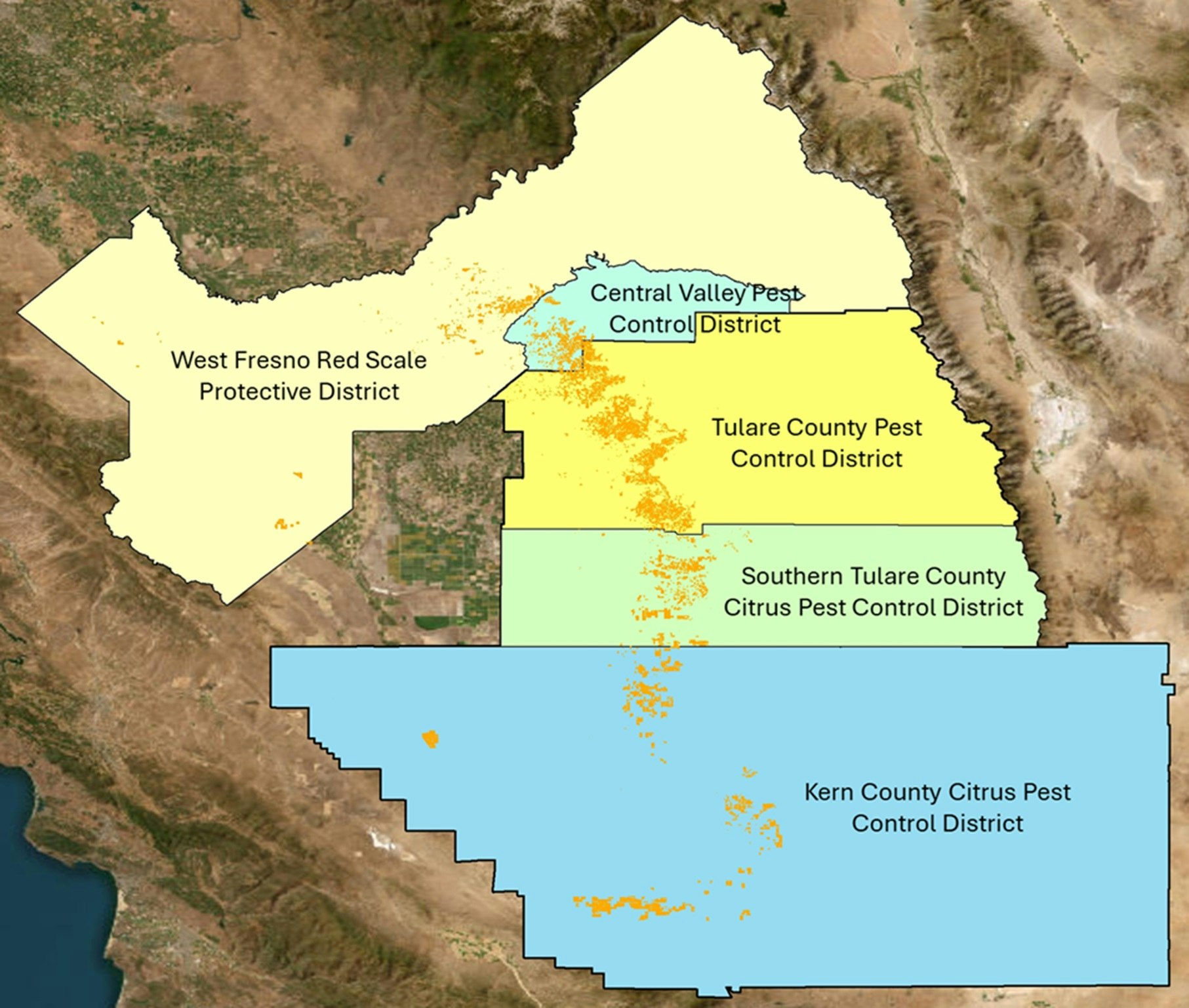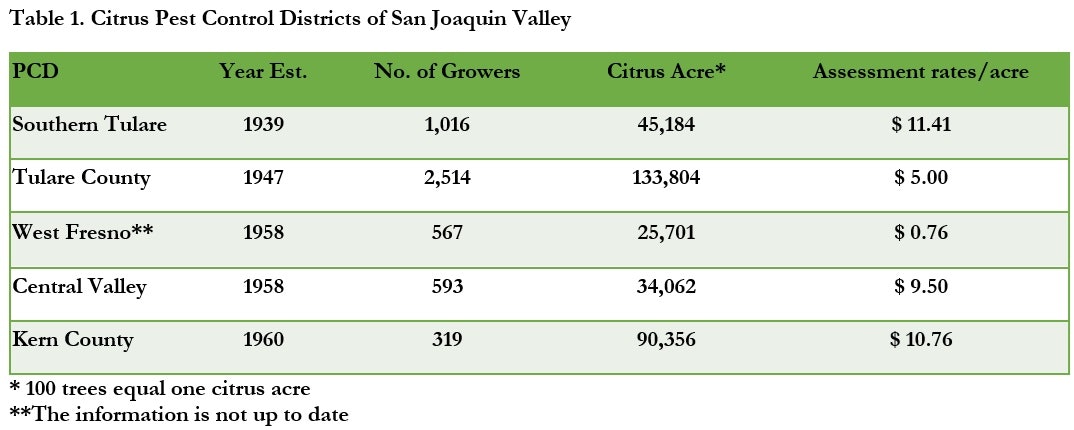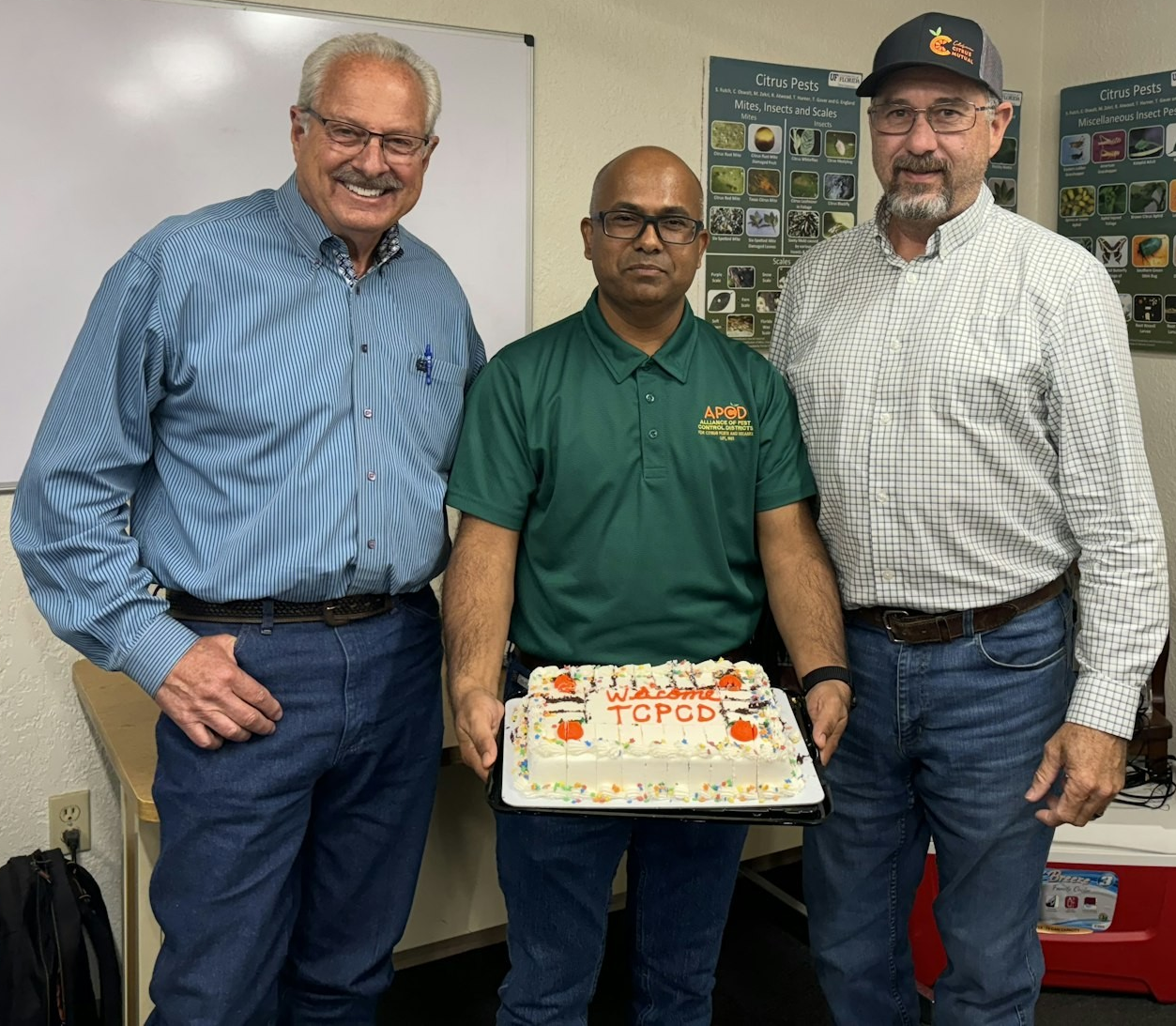About the APCD

Alliance of Pest Control Districts Expanding Service to Multiple Citrus Pests
Citrus Pest Control District leaders in the San Joaquin Valley have identified a need for their Districts to develop a unified, cooperative, regional effort to support and augment existing programs to protect the citrus industry against multiple citrus pests and diseases such as Huanglongbing (HLB) and its vector the Asian citrus psyllid (ACP), Citrus yellow vein clearing virus (CYVCV), Citrus leprosis virus (CiLV), Tenuipalpus phoenicis (flat or false spider mite), Toxoptera citricida (Brown citrus aphid), Citrus variegated chlorosis, fruit flies, and others.
Brief History:
California’s Citrus Pest District Control Act of 1939 allowed citrus growers to organize, operate, and govern pest control districts (PCDs) to effectively control and eradicate citrus pests of concern to the participating growers. These PCDs are boots-on-ground organizations responsible for developing and implementing multitactical pest and disease management programs and devising strategies for early detection of invasive citrus pests. There are five citrus pest control districts in the San Joaquin Valley (SJV): Southern Tulare County Citrus Pest Control District (STCCPCD), established in June 1939; Tulare County Pest Control District (TCPCD), established in April 1947; West Fresno County Red Scale Protective District (WFRSPD), established in July 1958; Central Valley Pest Control District (CVPCD), established in December 1958; and Kern County Citrus Pest Control District (KCCPCD), established in January 1960. Table 1 provides the details of each pest control district, including the assessment rates per acre of the citrus groves.

In 1960, these pest control districts created the Central California Citrus Pest Control Agency (CCCPCA) and signed historical joint powers agreements (JPAs) for efficiently combating Citrus Red Scale pest problem. By 1968, the Agency shifted focus to address the Citrus tristeza virus (CTV)-induced quick-decline by rebranding the agency’s name as Central California Tristeza Eradication Agency (CCTEA). In 1995, because of cost and low CTV detection numbers, West Fresno RSPD withdrew its participation from the JPA. Similarly, in 1996, with a higher number of CTV-infected trees, growers had objections to its removal, and thus Tulare County PCD also withdrew its participation from the program because of growers; on the other hand, in 2007, CTV detection on the Lindcove Field Station (LREC) increased dramatically and felt a necessity of a particular program to protect LREC citrus. TCPCD initiated a CTV survey and vector control program to protect the research plots and citrus clonal protection program (CCPP) foundation blocks on LREC. In 2009, CCTEA adopted a new ELISA protocol, which was MCA-13-based and targeted towards detecting and removing exotic and/or potentially severe, decline-causing strains of CTV. Since 2020, LREC has stopped removing non-severe CTV-infected trees in research blocks, but the MCA13+ reactive CTV removal continues.
As multiple regulatory pests were seen in neighboring counties' citrus groves, the agency planned and established a brand-new laboratory for the early detection of diseases and pests. In 2016, the agency received a non-regulatory Laboratory Permit from CDFA to test plant and insect samples for Huanglongbing (HLB)/Citrus Greening and ACP. The Citrus Pest Control Districts can now instill confidence in the growers to combat future challenges well, as they work closely with them to manage citrus pests with well-established laboratories and collaborate with USDA and other organizations.
Current Situation
In 2022, the live breeding population of ACP was discovered at a Packing House in Lemon Cove near LREC. In the same year, the Citrus yellow vein clearing virus (CYVCV) was discovered in Tulare, CA. On top of these pest and disease issues that threaten citrus industries, it faces multiple challenges, including water, labor, and taxes. Once established, disease and insect pests keep spreading, and it will be challenging to eradicate. Collaborative management efforts among SJV growers are necessary to manage the multi-pest and disease issues cost-effectively. In July 2023, CCTEA was rebranded as the Alliance of Pest Control Districts (APCD). It started shifting its focus to cover multiple pests and diseases along with a CTV survey and vector control program. TCPCD felt the necessity and officially re-joined JPA in July 2024. Re-joining of TCPCD was a significant event as more resources were needed to strengthen the regional pest and disease surveillance program and to combat the recent emergence of new regulated pests and diseases, such as ACP, HLB, CYVCV, and with the introduction of several exotic fruit flies in Southern California. This transformation symbolizes unity and collaboration among the districts, fostering a strong sense of common goals and shared responsibility.
APCD has restructured its objectives based on recommendations from the technical advisory committee and growers. It will focus on multi-pest surveillance and detection, with HLB and ACP as the primary targets. In addition to maintaining the multi-pest inspection surveillance, the SJV PCDs will continue to protect the LREC by funding and supporting the insect vector control program in citrus blocks around LREC.

"We are fortunate to have TCPCD as a part of citrus growers' alliance against invasive and destructive citrus pests. “With TCPCD, the largest citrus pest control district, onboard, APCD will be able to implement sophisticated surveillance and control programs to protect the SJV citrus industry from invasive pests, such as ACP, HLB, and fruit flies," stated John N. Fisher IV, Chair at APCD. “It’s a win-win situation for everyone; as a part of the alliance, citrus growers in TCPCD can quickly detect ACP or other invasive pests at a fraction of the cost compared to if they have done it alone. “Also, being the largest pest control district, TCPCD brings a huge number of resources to APCD,” says Milo Gorden, chair of TCPCD. Further, Mr. Gorden stated that these moves are necessary to improve the PCD's position, advocate for the industry, increase local control, increase government funding, reduce duplication of efforts, and discover opportunities to work more cooperatively with the state and federal agencies in a united effort to confront the future. The Alliance of Citrus Growers is growing and getting better equipped to combat multiple citrus pests and diseases, a promising development for the industry.
Future Directions
HLB and ACP have taken footholds in Southern and Coastal California. An uneven distribution and low titer of HLB bacteria in plants make early detection of infection difficult, as it can take 6 to 12 months or more before the first symptoms become visible. During this incubation period, infected trees can act as a source of inoculum and let ACP further spread the bacteria. Previous studies have shown that the ACP vector can move up to 2 miles in 12 days. Therefore, the effective management and control of vector spread also depends on the collaborative efforts of all growers in the valley. Although HLB-infected trees have not been found in SJV, ACP is regularly intercepted in the valley, exposing citrus blocks to potential HLB-positive ACPs. Since there is no cure for HLB, the effective way to manage HLB is to make sure ACP does not get a foothold in SJV. This would require an effective areawide trapping and inspection program to detect infected trees early (even before symptoms develop) and inoculum removal sooner.
TCPCD's joining of the citrus grower’s alliance has greatly enhanced the APCD's ability to inspect and set up traps in blocks predicted to be most vulnerable to ACPs hitch-hiking. The next practical step would be to help neighboring counties with substantial citrus acreage, such as Madera and Kings, establish their pest control districts and invite them to the JPA. We also would like to heartily welcome the rejoining of the West Fresno Red Scale Protective District as we are only as strong as we are united. “We must establish a clear path to deal with HLB and other invasive citrus pests before they arrive and ensure sufficient funds along with the dedicated protocols to promote an immediate, effective, and sustainable response," stated Subhas Hajeri, Managing Director of APCD. As citrus growers continue to grapple with evolving threats, collaborative efforts involving government support, regulatory clarity, and innovative solutions are essential for early detection and elimination of ACP to ensure the success of the California citrus industry against HLB and other invasive pests and diseases.
